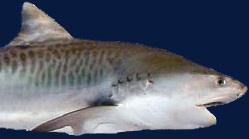GNPD begins tagging tiger sharks in Galapagos for 2016
News Release
Galapagos Conservancy
18. July 2016
— — — — — — —
 Last week, rangers from the Galapagos National Park Directorate (GNPD), in coordination with the Charles Darwin Foundation, began satellite tagging tiger sharks in the central areas of the Archipelago.
Last week, rangers from the Galapagos National Park Directorate (GNPD), in coordination with the Charles Darwin Foundation, began satellite tagging tiger sharks in the central areas of the Archipelago.
At sites known for having a high presence of tiger sharks, such as the Itabaca Channel between Baltra and Santa Cruz Islands, rangers and scientists capture a shark and attach it to the boat with a safety harness that immobilizes it, and then proceed to place a satellite tag on the dorsal fin of the animal. The methodology used for placement of the satellite tags meets protocols that prevent damage to the animal while ensuring the safety of the technical and scientific staff involved.
The satellite tags emit a signal that is received at the Control and Monitoring Center of the Galapagos National Park on Santa Cruz Island in real time. With this monitoring technique, technicians can track the sharks tagged to determine their areas of displacement and movement. The satellite tags can output the signal up to one year.
This activity is part of a long-term monitoring and conservation program of sharks within the Galapagos Marine Reserve (GMR) that the GNPD has implemented, in collaboration with other institutions, for more than nine years. The goal of the program is to learn the migration patterns and distribution of the main species of sharks, including tiger sharks and their fidelity to certain sites.
The information collected by the satellite devices is analyzed and consolidated with other studies, which allow administrators of the GMR to implement management measures for the protection of this species in the sensitive areas for the tiger shark, such as zones of feeding and reproduction.
On last year’s monitoring trips, 9 tiger shark were tagged, including 5 females and 4 males. So far this season, 2 individual sharks have been tagged.
Content based on a press release from the Galapagos National Park Directorate, translated with their permission.
Source: Galapagos Conservancy
